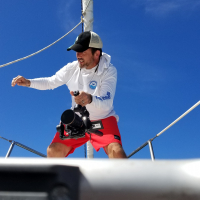Our Neighborhood
 JonaBeth Russell
Registered Users Posts: 1,065 Major grins
JonaBeth Russell
Registered Users Posts: 1,065 Major grins
I've always had a draw to the stars and our wonderful Milky Way neighborhood. What mysteries lie up there? Surely there's more than just gas & rock. Answers to ancient questions?
Here's some food for thought. Earth orbits around the sun, as most would agree, in an ellipse. However, most of us forget that the sun is orbiting in an ellipse around the center of our Milky Way galaxy, dragging us with it. On top of that, our Milky Way galaxy is hurling toward the largest galaxy in the system, Andromeda at a little over 100km per second.
So, even though your Earth birthplace is stationary, and you can visit where you're from, the fact is, none of us have or ever will be where we were born again. Think about that next time someone asks, 'Where are you from?'
I was inspired by @Stumblebum to create this shot, having seen his amazing stargazer images. This was my first astrophotography go with the Sony A7Riii, shot around 8:15pm (pretty early, but I like the results). I learned a lot from the few frames I shot, such as next time either turn on LENR or shoot black frames. #hotpixelclonemadness
Once I get this camera a little more dialed in, I'll head to the summit of Haleakala for a night of shooting.
Aloha!

Comments
Stunning.
Gallery: http://cornflakeaz.smugmug.com/
Well done, JonaBeth. You'd be hard pressed to find someone more accomplished than Taz when you seek to emulate the best. We're fortunate, however, to be blessed with many really good shooters on this forum, including yourself.
Great capture. I agree with Don, and Tom. We are fortunate to be able to learn by example, from so many talented shooters on this forum. Is the light pollution from Lahaina?
Phil
Luck happens when preparation meets opportunity!
Very nice, JB! I like the lighting on the human subject.
The problem with LENR is that it takes as long as your exposure, thus doubling the amount of time it takes to take each picture. That will kill your ability to stack and make panos, and take continuous shots for capturing meteors. However if you shoot a few dark frames instead, you can apply them to all of the shots you take in post.
Not sure about for Sony, but Lightroom automagically fixes hot pixels in the RAW conversion for my Canon bodies. I have no clue how it works, but I never see them.
Link to my Smugmug site
Mahalo for these words!
There are a couple different pollution sources in the image. One from Lahaina, the other from Ma'alaea, and a third heavy one from the sun, creating a glow of sorts in the left horizon area. And of course, the houses behind me on the Makena coast were plenty lit up as well.
This is why I've been leaving LENR set to OFF, for exactly that...stacking and whatnot. LR usually can handle a singular hot pixel, but for some reason I found that all of my visible pixels spots where actually 2 pixels, side by side. I found a way to force the camera into re-mapping the sensor, which should help a little. However, Lightroom algorithms don't allow for anything more than a single pixel to be subtracted, as they are fearful of removing actual photo details. Someone told me Capture One can handle Sony hot pixels best, but I think I'd prefer to try using black frames, so as to keep from bouncing between editing platforms.
Here's another frame from the evening. Again, hot pixels all over, I cloned those in the water & rocks, skipped those in the sky mostly, because it doesn't seem to matter much there.
Epic JBR!
Great shot. Love the first one.
My Website | My Blog | My Facebook Page | My YouTube